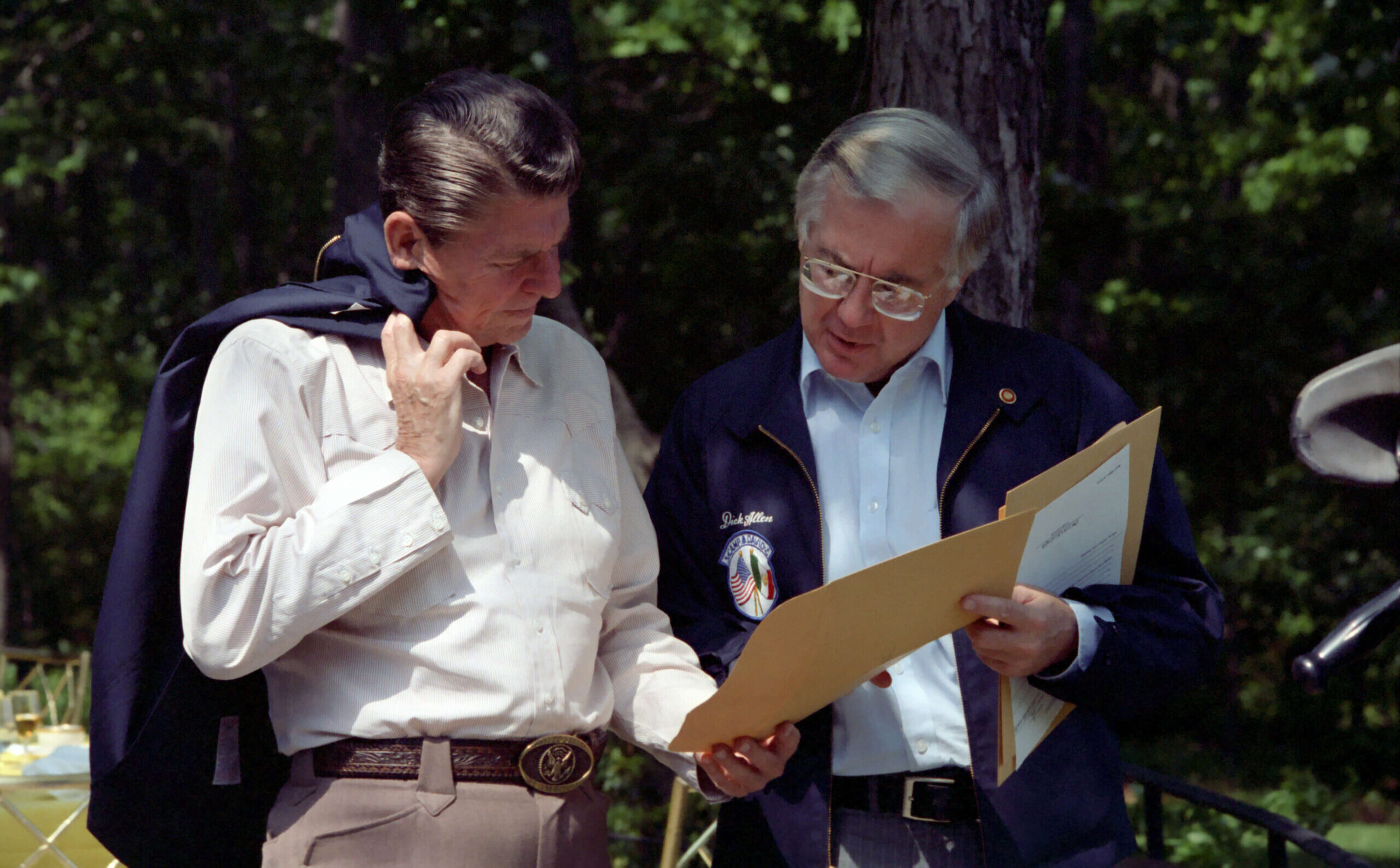Esther in America: The Scroll’s Interpretation in and Impact on the United States
Stuart Halpern, ed.
(Maggid, 2021)
Stories passed along from generation to generation often serve less as a portal to the past than as a mirror for the world in which the audience lives. The Hebrew Scroll of Esther—better known as the Book of Esther to Christians—is one such story. The new essay collection Esther in America shows that the lessons Americans have drawn from the ancient tale of Mordecai and Queen Esther say far more about the scroll’s readers than they do about the story’s internal content. By investigating how they read Esther, we can learn how they saw themselves and their own challenges.
A refresher: The Scroll of Esther describes the near-annihilation of the Jews in sixth-century BC Persia. According to the narrative, King Ahasuerus needs a new queen and crowns a Jewish woman named Esther—which translates roughly to “hidden”—who hides her religion. Meanwhile, Ahasuerus stamps his approval on his evil vizier Haman’s plan to wipe out the empire’s Jews. Esther, with her uncle Mordecai’s guidance, exposes Haman as the enemy of the queen and her people, bringing the king’s wrath down upon him. All is turned upside down, as the date planned for the Jews’ obliteration becomes their great day of celebration, and Haman hangs on the gallows he had built for his enemy Mordecai.
Although the Scroll of Esther is now best known for ritual readings on the Jewish holiday of Purim, its current status as the near sole province of religious Jews is a historical anomaly. Since the colonial era, it has been a recurring source of inspiration not only for American Christians but also for both sides of various political disputes, including the abolition of slavery and women’s suffrage. Reading Esther in America, it’s easy to see why. The story that the scroll tells is surprisingly modern. Assimilation, sex, power, revenge—combined with the conspicuous absence of prophecy, overt miracles, or God’s name—make the Scroll of Esther the most human-driven book in the Bible.
This anthropocentricity has inspired Esther’s students to become active participants in the politics of their own time. Such stories make up the bulk of Esther in America. Two major themes emerging from these examinations shed light on the responsibilities of American citizens, especially religious citizens, today.
The first is confronting the problem of diminishing moral clarity. In a country such as America, which was once convinced of its fundamental goodness but increasingly considers itself stained by unsavory compromises or outright villainy, a story that clearly demarcates heroes and villains no longer sits well.
The second, related theme is the deft use of power. Esther and Mordecai, minorities in a pagan polity, must use power for the benefit of their own people without arousing suspicion that they might be acting against Persian interests. They are, as Jews remain and religious Americans of all creeds increasingly become, members of “a nation scattered and separate among the nation, whose rites are different from all nations.” Yet, as Mordecai tells Esther, “who knows if for just this moment,” or this purpose, “you have joined the royalty?”
Colonial patriots identified with the Jews of the Purim story: freedom-seeking and benign. To them, this story had clear heroes (Mordecai and Esther), a villain (Haman), and a great mass of people deserving of salvation. One creative interpretation from the revolutionary era held that the Jews were persecuted for being “inclined to republican principles.” Mordecai was called “that great patriot” for his refusal to capitulate; Haman became a British imperialist, “whose ruling passion is the lust of power.”
If eighteenth-century Americans primarily venerated Mordecai, it was Queen Esther who provided moral inspiration for nineteenth-century abolitionists. To women such as Uncle Tom’s Cabin author Harriet Beecher Stowe, Esther was a prototype for those who “could no longer remain in the realm of the female” and now had to use “rhetoric and logic to persuade” men of slavery’s immorality. Esther taught the art of persuasion, using her words to gain the king’s trust. Stowe and Sojourner Truth invoked her bravery to stir Civil War–era women to realign America with its founding values.
But such clarity about America’s fundamental goodness soon became clouded. Americans’ shifting sense of who deserve adulation is reflected in the emphasis on a minor character, Queen Vashti. For reasons unclear, Vashti refuses Ahasuerus’s demand that she appear at his banquet and is replaced by Esther. Traditional commentaries vilify the Persian queen, ascribing her refusal to vanity. Lately, however, Vashti has largely supplanted Esther as the preferred heroine. The discarded and disgraced queen has been reborn a defiant feminist.
Although Vashti’s resurgence began with an alliance of feminists and abolitionists in the nineteenth century, her prominence grew as she came to represent subaltern groups who saw in the character a symbol of the need for cultural change. Biblical exegesis, like so many other aspects of Western society, had been the province of men—in America, mostly white men. It was they who lionized Esther and Mordecai, leading activists to conclude that the traditional reading “merely reinforced the hierarchical structures that further entrapped them.” With the recent surge in American historical revisionism, Vashti’s reputation has flourished. Toni Morrison’s fiction features several Vashtis. An organization bearing her name aims to “strengthen the presence and voices of black women and girls as progressive facilitators.”
Reclaiming antiheroes—or, at best, secondary characters—to flout traditional readings has become something of a pattern. Jewish feminists claimed Lilith, a demonic first wife to Adam mentioned in some Midrashic traditions, for their movement’s flagship periodical. The feminist website Jezebel gets its name from the murderous queen of Israel in the book of Kings. One who sees in Esther virtue and political shrewdness must be saddened that her example did not suffice. And it leaves the lingering suspicion that those who latch on to Vashti are less interested in learning from the Scroll of Esther than they are in subverting it.
Inasmuch as this trend reflects an America increasingly attentive to those who traditionally receive less sympathy, it is to be welcomed. But inasmuch as it reflects an America that sees itself more as Ahasuerus oppressing Vashti than as Esther fighting for what is fundamentally good, it exposes a moral confusion that edges toward perversion. If the Scroll of Esther is merely one more lens through which America becomes an oppressive regime, then its readers will have irreparably tarnished the mirror for future generations.
Yet those who scour canonical texts for hints of political wisdom will find insights. One such insight reifies the sorely needed distinction between idealism and statesmanship. Mordecai alone, pious and passionate, could not have saved the Jews. He was a guiding light pointing Esther to proper ideological ends, but he lacked Esther’s access to the levers of power and her sense of timing.
In this reading, Esther is analogized to Lincoln, who waited for victory at Antietam before proclaiming the emancipation of rebel-held slaves (although not slaves held legally under the Union). While he sympathized with the Mordecais of his day—namely, abolitionists— Lincoln understood that even a president could falter in his loftiest moral ends if he did not proceed with caution.
This is useful advice for a political moment dominated by ideologues. “To celebrate Esther, and to celebrate Lincoln,” writes Rabbi Meir Soloveichik in one essay, “is to reflect not only on moral heroism but also on statesmanship, on the ability to achieve moral goals, at times through means that are less than ideal.” The activist asks, “If not now, when?” The statesman answers: “When the opportunity is ripe.”
Soloveichik’s appeal to prudence is useful for politics in general but holds particular importance for religious Americans. Americans of faith in our militantly secular age are now akin to outsiders in the palace. Like Jews under Persian rule, we wonder how to preserve a nation whose elite culture scorns strange and different rites.
The quintessential outsider in the palace, Queen Esther, has a good answer. It is an answer that was historically reserved for young Jewish women implored to follow Esther’s path but today speaks to anyone dissenting from the cultural mainstream. Unlike the generals and warriors who appear elsewhere in the Hebrew Bible, Esther’s “essentially feminine” heroism was her dedication to moral education. Instead of entering battle, Esther’s persuasive example allowed her to bring the Jews of the Persian Empire to fasting, prayer, and faith in God.
What used to be called feminine heroism, we may now call civic virtue: teaching and modeling the behaviors that make self-government possible. A system including checks and balances, a culture of liberty and pluralism, and a vibrant civil society is by nature calculated to protect the welfare of religious minorities. But it is not self-sustaining, nor can politicians or princes alone be expected to uphold it.
Religious people, the Esthers in today’s halls of power, can take the lead by modeling the characteristics Esther embodied that allow people of various heritages to live together in peace and prosperity. Preserve the uniquely republican elements of this country and we can preserve its role as haven for those persecuted by contemporary Hamans. Esther in America has the peculiar power of making religious people especially cognizant of the dual traditions, religious and national, we are blessed to perpetuate, with all attendant privileges and responsibilities. For Jews, observes the novelist Dara Horn, Esther was “a story that ennobled us, and made us confident in our role in this great country.” With America suffering its own crisis of faith, who knows if it is for just this moment that Jews’ confidence was intended?
Tal Fortgang is a law student and freelance writer living in New York















